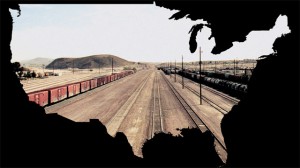Over a period of three weeks this month, a public art extravaganza featuring a changing cast of “artists, musicians and creative pioneers” will make its way across the country by rail. Station to Station, as it is called, is a project by multi-media artist Doug Aitken and made possible by Levi’s, whose corporate sponsorship has quietly supported a number of recent public art projects. The list of participants in Station to Station is an impressive array of creative personalities — too many to list here — including Patti Smith, Ernesto Neto, James Turrell, Alice Waters, Theaster Gates, Olafur Eliasson, and Nam June Paik, among many others. The train started in New York with stops in Pittsburgh, Chicago, Minneapolis/St. Paul, Santa Fe, Winslow, Barstow, and Los Angeles along the way — this magical mystery tour will end in Oakland on September 28. As of this writing, tickets are still available for the concluding event in Oakland’s historic 16th Street Train Station.
“For a brief moment,” it says on the website, “the most interesting place in the country will be a moving target.” The train itself will be a moving kinetic light sculpture — additionally the programming is designed to bring together widely known creative figures with local legends from each municipality. A broad spectrum of cultural interventions and site-specific happenings will be on offer, drawing from art, music, food, literature and film. Oakland will see performances by Dan Deacon, Lia Ices, No Age, Savages, Sun Araw and The Congos, and Twin Shadow, among others, along with art by Kenneth Anger, Urs Fischer, Liz Glynn, Evan Holm, Carsten Höller and Ernesto Neto — all staged in and around Oakland’s historic landmark train station designed circa 1912 in the Beaux Arts style by renowned architect Jarvis Hunt. Moving images by Allora & Calzadilla, Dara Birnbaum, Yayoi Kusama, Raymond Pettibon, and Ryan Trecartin, among many others, will be featured along with “printed matter” by a host of incredible artists, including Abraham Cruzvillegas, Karen Kiliminik, Catherine Opie and Ed Ruscha.
In a time when public funding for the arts is diminishing, the trend towards privatized endeavors is increasing. The implications of these undertakings — how they impact who makes what where and for whom — is open ended, as noted by Glen Helfand in a recent article that examined Open Canvas, a public art initiative supported by ABSOLUT. The Bay Area has seen a number of corporate projects like this recently. Additionally ShockTop Belgian Ale, a subsidiary of Anheuser-Busch, organized a street party to present a billboard assembled from the beer’s ingredients. THE THING QUARTERLY recently partnered with Levi’s to present Moment to Moment, an international series of urban interventions foregrounded by a thoughtful essay about artists’ media interventions written by San Francisco scholar Gwen Allen. In each of these situations, as Helfand noted, the participants appeared to be “well-treated, well-fed, and well-documented” — typical benchmarks of good business, along with “well paid,” which has apparently also been the case according to artists I’ve spoken with off the record.
For its part, Levi’s seems largely invested in good business practices across the spectrum of its product, from worker’s rights to environmental issues to investment in artists as a form of “social branding.” (Certainly it is also good marketing that Internet searches for any of its art programs yields instant advertizing of its clothing — immediately after searching for Station to Station, a Levi’s ad popped up in my newsfeed and because my computer is so smart, it knew exactly what to show me based on previous searches. This is not a coincidence.) Supporting art makes for good marketing, so long as everyone is on message — and the message is always going to be determined by the money. But to argue both sides of the issue, in art the money extends far and wide, and includes patrons, museums, galleries, grants, and publications. By and large, art is a commercial endeavor, no matter how you consider it.
Though it seems unlikely that corporate benefactors will support politically potent, radical or controversial artworks, perhaps the support leveraged by these popular and populist “public art” opportunities will allow artists to engage in work that challenges us to think differently about the world around us. Or perhaps these associations will have a more insidious impact, harnessing artists to a brand identity. Everyone needs to eat, to be sure, and artists need to make a living in order to make their work authentically. The hope, of course, is that through these types of corporate opportunities, artists will be able to do both.


